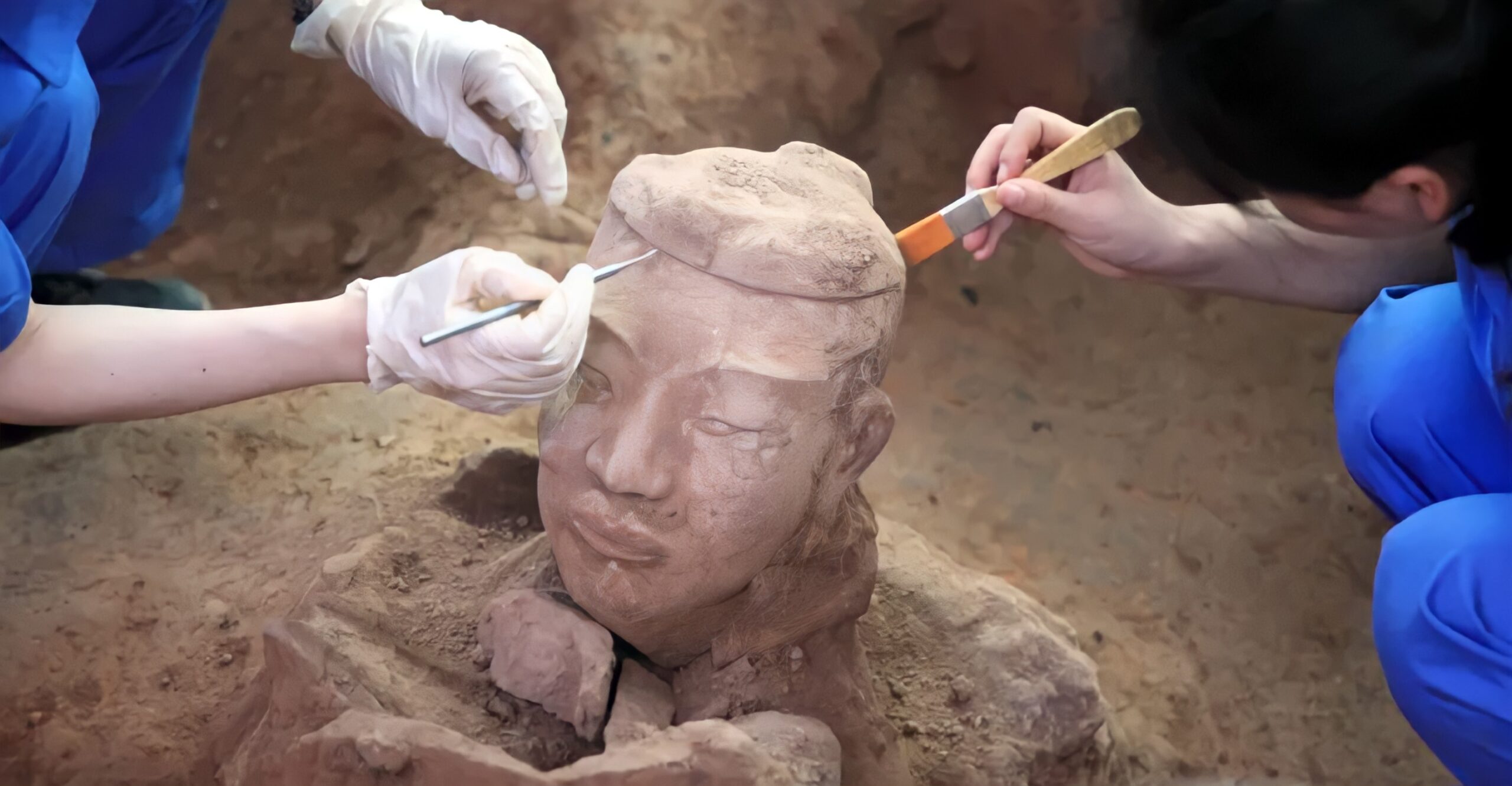
Archaeologists discovered an important artifact in an equally important place. In 2018, a Roman grave was found in Frankfurt, Germany. This alone was an archaeological marvel, but it was what was inside the grave that could change what we know about the origins of Christianity. Inside the grave was a human male, and alongside him was a piece of jewelry he would have worn when he was buried – a small silver amulet.
This single piece of silver could challenge how we thought Christianity spread into northern Europe. It could mean that Christianity was adopted in regions decades earlier than previously thought.
The Amulet

The silver amulet was well-preserved due to being locked away inside of the grave with its owner. However, researchers soon found something unprecedented about the piece of jewelry: it had something inside of it – a thick piece of silver foil, and on the foil was an inscription that couldn’t be read.
Before researchers could even start comprehending what could be inscribed on the silver foil, they faced a problem that similar relics have – due to the amount of time that had passed, the foil had become exceptionally delicate.
Using Cutting New Technology

Archaeologists have found ancient scrolls with a similar issue. Any historical context that the inscriptions could offer researchers is sealed off and would “self-destruct” if any attempts were made to unroll them. This meant that when the silver foil was found, it couldn’t be transcribed, at least not yet.
Researchers knew that unrolling the foil would destroy it and any hopes of knowing what significance the text had. Things changed just a year ago when the silver foil was re-examined using cutting-edge technology that allowed researchers to scan it. Using this method, a digital replica could be made and unrolled.
The Inscription

The text on the silver foil was identified as Latin, which would be expected from the time period, ranging from 230 – 270 AD. There were 18 lines of text on the foil, which would have otherwise been locked away forever if the grave wasn’t found or technology hadn’t allowed for such amazing insights.
After the researchers had their copy of the silver foil in a digital space where no harm could come to the real artifact, they could finally find out what was written inside.
Mentioning Key Figures

Unrolling the foil after all this time could have shown nothing or perhaps an innocuous bit of text. However, what it was hiding had a story to tell that would change what we know about Christianity in the region where it was found.
The inscription mentions key figures like Saint Titus and Jesus Christ, acknowledging him as God’s son. The implications this inscription has is monumental, as other mentions of Christianity in the region only date back as far as the 4th century.
A Unique Relic

The amulet found in Frankfurt is very unique as far as religious amulets go. Many others tend to merge different religious aspects, such as Judaism, Christianity, and paganism. However, the silver amulet seems to refer to Christianity only and does not mention angels or pagan deities.
This implies that there was a more unified belief system that its owner held onto, at least enough for them to hide it inside of the amulet and be buried with it.
Purely Christian Beliefs

While this amulet is the first of its kind to be found in this region, that doesn’t mean that others didn’t hold similar beliefs. In fact, the amulet’s inscription, being found at all, suggests that there could have been a community that shared these early beliefs in Christianity.
The text mentions Jesus Christ and monotheism, which is unprecedented for the time period it is believed to come from. As cultures merged, there was an intermingling of many traditional beliefs at the time, but this artifact shows an established Christian faith earlier than believed.
The Spread Of Christianity

Before the amulet’s inscription was deciphered, historians believed that the spread of Christian missions only established the religion in the 4th century. However, the inscription predates previous evidence and means that how quickly the religion spread throughout northern Europe should be re-evaluated.
There has been little evidence to support coordinated and established Christian beliefs and teachings from before the 4th century until now. This evidence alone is enough to at least make historians consider making amendments if proven authentic.
Notions Can Quickly Change

Whatever community created the silver amulet was undeniably a wholly Christian one, which indicates that high concentrations of Christian worshippers were around for decades longer than otherwise thought.
As archaeologists uncover more about the past, previously established notions can quickly change. Years from now, more evidence could be uncovered until the first origins of Christianity north of the Alps are found.
A Coordinated Belief

The silver amulet not only mentions Jesus Christ, an undeniable Christian figure, but also Saint Titus, a close follower of Paul and an important leader in early Christianity. The amulet mentioning Saint Titus shows an appreciation for Christian figures and wanting to follow early core Christian Beliefs.
Communities or individuals looking for traditional teachings of this faith imply that Christianity’s foothold in the region north of the Alps during this time could have been quite prevalent, even if worshipped in isolated pockets.
Commitment To One Faith

Other amulets from this time show less commitment to Christianity as the one deniable faith, rather worshipping elements from other belief systems as well.
The inscription, in its entirety, shows a coordinated following of the religion and not a disorganized, vague belief of faith. This could update previous notions of early Christian beliefs, which were isolated cases and usually mixed in with other religions at the time.
The Grave

There is more context around the grave. It was found as part of a greater Roman cemetery that is now part of Frankfurt-Praunheim, which was previously part of ancient Nida. Other artifacts found in the cemetery were incense burners and pottery.
These artifacts are in good condition, given their age, and could have held religious purposes, although this still isn’t conclusive.
A Ritualist Burial?

The amulet could be part of a ritualistic burial for those who followed the faith in these communities and shows how Romans adopted Christianity over time.
The inscription being hidden inside of the amulet also indicates how those who openly believed in the religion could have faced prosecution from others in the region and time period.
Technological Innovation

Only six years after the amulet was found could technological innovation unlock its secrets. This shows how constantly developing technology can be adapted to be used in scientific fields to learn more about previously found artifacts.
It is important for scientists to explore other artifacts that could have been overlooked without the technology we have today.
Leveraging Technology In The Future

Physically unrolling the scroll would have led to its destruction, most likely losing any knowledge that could have been gained in the process.
Digitally unrolling fragile artifacts is an amazing leverage of new technology, and has also been used on the En-Gedi scrolls. This technology could be used on more artifacts previously found are any uncovered in the future.
Changing Notions

The silver amulet from Frankfurt is a paradigm-shifting artifact, and should change the notions of how and when Christianity spread across 3rd century regions. Christianity could have been worshipped more openly and in more ordered ways than previously believed.
To think that such a substantial piece was locked away inside of a piece of jewelry from nearly two millennia ago. If the grave was found any earlier, it could have faced pilfering or destruction, meaning the knowledge within could have been lost to time.
Previous Understandings

It was a common consensus among expert historians that the region of Europe north of the Alps had a gradual rise of religious beliefs, and Christianity was slowly adopted and influenced by the southern regions.
However, isolated worship seems likely with the new evidence researchers have uncovered from the inscription.
Far-Reaching Impacts

This archaeological discovery has massive implications for religious studies, anthropology, and the historical record of Europe. Burial sights could be re-evaluated in the context that the amulet has given to late Roman beliefs.
This new historical context could motivate archaeologists to look more closely at the region for potential gravesites and the opportunity to find more personal items like jewelry that could present intact religious scripts.
New Evidence Is Always Being Uncovered

The origins of cultural and religious beliefs are always in flux – new evidence found in the future may provide more knowledge of the time period and could either support the amulet or contradict it entirely.
Either way, our historical understanding of early adopters of religions in Europe and other continents will become richer with every new archaeological dig.
New Questions And Future Research

The discovery of the amulet and the implications of the inscription within have presented questions not only for regular people but also for historians. There is still a lot of context that would help researchers understand the amulet even more, such as who created the amulet and if it was a single example or produced in numbers for Christian followers.
Are there even earlier Christian graves that haven’t been found yet? Future studies and findings could unlock more of the past in this specific region and help us understand more about how Christianity spread across Europe.






